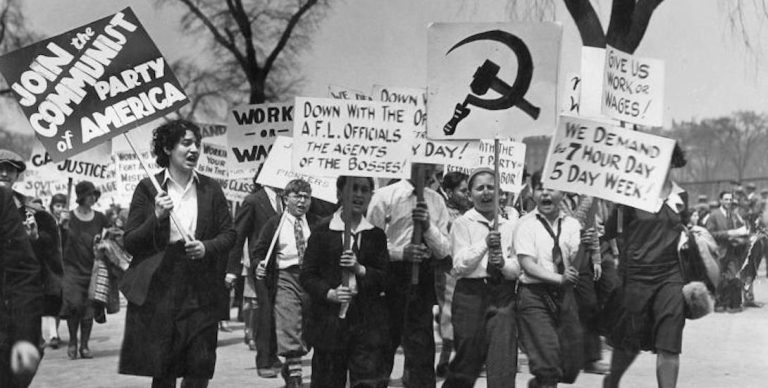
From Revolution to Repression: How the U.S. Communist Party Gained Influence—And Lost It All
New York, N.Y.—In the smoky backrooms of Greenwich Village and the bustling union halls of Detroit, the American Communist Party (CPUSA) once thrived as a radical force in U.S. politics.
At its peak in the 1930s, it commanded tens of thousands of members, influenced labor movements, and even shaped New Deal policies. My uncle, Dr. David Luce, and my mentor, Betty Millard, belonged to “the Party” before the McCarthy Era. Yet, by the 1950s, it was a shadow of itself, decimated by government crackdowns and internal divisions.
This is the story of how the CPUSA rose—and why it fell.
The Birth of American Communism
The CPUSA was born in 1919, a product of the global revolutionary wave following Russia’s Bolshevik Revolution. Split from the Socialist Party of America, its early years were marked by factionalism and underground organizing.
The Great Depression, however, became its turning point. As unemployment soared, the CPUSA positioned itself as the vanguard of labor rights, organizing strikes and fighting for racial equality—a rarity in segregated America.
By aligning with the Soviet Union, the party gained ideological direction but also became a target. FBI Director J. Edgar Hoover saw communists as an existential threat, laying the groundwork for future repression.
The Popular Front and Wartime Influence
In the mid-1930s, the CPUSA adopted the Popular Front strategy, softening its rhetoric to ally with liberals against fascism. This shift brought temporary legitimacy—membership swelled to nearly 100,000 by 1939. The party played key roles in labor unions like the Congress of Industrial Organizations (CIO) and championed civil rights, even defending the Scottsboro Boys.
World War II further boosted its standing. After the Nazi invasion of the USSR in 1941, the CPUSA fervently supported the U.S. war effort, earning praise for its anti-fascism. But this loyalty to Moscow would soon backfire.
The Red Scare and Decline
The Cold War turned communism into America’s enemy. The Smith Act trials of 1949 imprisoned party leaders, while Senator Joseph McCarthy’s witch hunts purged suspected communists from government, Hollywood, and unions. The CPUSA fractured—some members fled underground, others, such as Uncle David and Betty Millard, renounced Marxism entirely.
By the 1960s, the party was a relic. Younger radicals embraced New Left movements, dismissing the CPUSA as outdated. Despite brief revivals, like its opposition to the Vietnam War, it never regained prominence.
Legacy and Lessons
Today, the CPUSA lingers as a minor political group, its history a cautionary tale of ideological fervor and state repression. Its successes—labor rights, anti-racism—were absorbed by mainstream progressivism, while its failures highlight the perils of foreign allegiance in U.S. politics.
In Summary
The American Communist Party rose as a radical force in the 1930s, championing labor and civil rights before Cold War repression crushed it. Its legacy endures in progressive movements, but its downfall remains a lesson in the costs of extremism and state power.